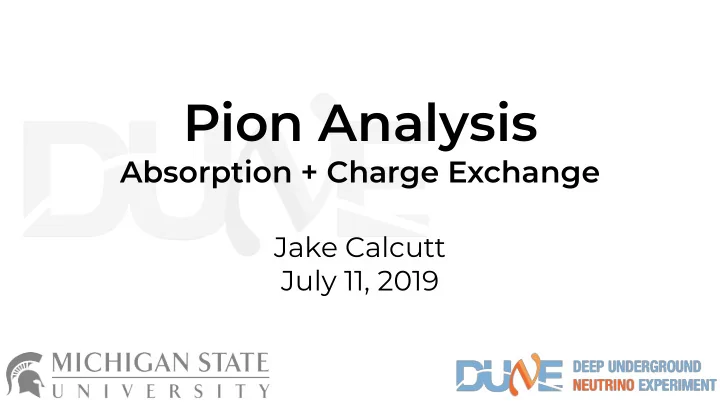

Pion Analysis Absorption + Charge Exchange Jake Calcutt July 11, 2019
Jake Calcutt 2 Introduction In addition to the total (elastic + inelastic) cross section, exclusive (subsets of inelastic) pion-Ar cross sections provide useful information Have the added benefit of unique signals Exclusive channels:
Jake Calcutt 3 My Goal For now: build an event selection for Absorption and Charge Exchange events Eventually: Make a cross section measurement across range of momenta This talk: shows some studies of MCC11 in my progress towards the event selection
Jake Calcutt 4 Event Topologies Absorption π + X X π + Charge Exchange π 0 X = Nucleons
Jake Calcutt 5 Signal Definiton Birds eye view: Pion interaction with no charged pions in final state Look for interactions without MIP in final state ● Attempted cutting on average dE/dX along the track ●
Jake Calcutt 6 dE/dX of Daughter Tracks Looked at all reconstructed daughters coming out of the primary pion tracks Averaged dE/dX from Collection plane by number of hits Backtracked reco daughters to true PDG (provided by the MCParticle contributing the most deposited energy)
Jake Calcutt 7 dE/dX of Daughter Tracks Abs+Cex All BG Pion Interactions Abs Cex
Jake Calcutt 8 Observations Within this signal there should be no charged pion daughters Scanning these events showed that these backtracked to the incident pions Abs+Cex More on this later
Jake Calcutt 9 Observations Particularly in Absorption, there is a peak in dE/dX < 2 MeV for protons Need to investigate Abs
Jake Calcutt 10 Observations The gammas from the pi0 decays are quite often reconstructed as tracks, and contaminate the MIP-like region Cex Will come back to this in a few slides
Jake Calcutt 11 Observations Muons are sometimes associated as daughters to the signal Later: I have some insight on this Cex
Jake Calcutt 12 Pions Associated as Daughters Cursory glance at events show tracks splitting at elastic scatters This is working as intended (I did not realize this at first)
Jake Calcutt 13 Pions Associated as Daughters Need to change the way I treat/think about these tracks Normally, I think about pions similar to Geant: the pion is one track up to the inelastic interaction/decay → elastic scatters along the track are included in this Now: Should I treat this as BG? What about low-angle elastic scatters that aren’t reconstructed?
Jake Calcutt 14 π 0 Decay Gammas The shower CNN ID can be used to pick out gammas from π 0 decays and disregard during Cex MIP-rejection Sum up scores from all hits in a track, divide by N hits BG
Jake Calcutt 15 χ 2 -based PID Tingjun pointed me to a PID technique developed for MicroBooNE: Fitting reconstructed dEdX vs Range to proton template More sophisticated than average dEdX along the track
Jake Calcutt 16 χ 2 -based PID BG Abs+Cex Still need to deal with Pi0 decay and charged pion reco Implemented in ProtoDUNETrackUtils “issues”
Jake Calcutt 17 Muon Daughter Tracks Started investigating where muons are coming from (should be none from Decay since I’m only looking at EndProcess == “pi+Inelastic”) Abs+Cex events Looking at true origin and backtracking the parent particles 2 Total Decay: product of primary decay Decay+: primary daughter decay Decay++: primary granddaughter decay
Jake Calcutt 18 Muon Daughter Tracks Started investigating where muons are coming from (should be none from Decay since I’m only looking at BG events EndProcess == “pi+Inelastic”) Looking at true origin and backtracking the parent particles Decay: product of primary decay Decay+: primary daughter decay Decay++: primary granddaughter decay More downstream decays from π + → π ∓
Jake Calcutt 19 Daughter Track Starting Points Investigating why cosmics are assigned as daughters. Tried looking at distance to end of primary track Note: distance comes from closer of start or end of daughter track to end of primary track Abs+Cex BG
Jake Calcutt 20 Daughter Track Starting Points Hand scanning a few events from MC. I noticed this interesting case (High stats sample w/ sce, run 2, subrun 3, event 484) Beam π + (28) has an elastic scatter, Pandora recognizes this and creates a new track (23). It ends in an inelastic interaction and creates a proton (70) that is associated as 28’s daughter. Additionally, a cosmic (30) is associated as a daughter
Jake Calcutt 21 To-Do Reconsider how I’m treating elastic scatters before the inelastic ● interaction Disregard Pi0-gammas in MIP-rejection in daughter tracks ● Look into shower daughter information ● Look at MCC12 (these studies was done using MCC11) ●
Jake Calcutt Thanks for listening
Recommend
More recommend